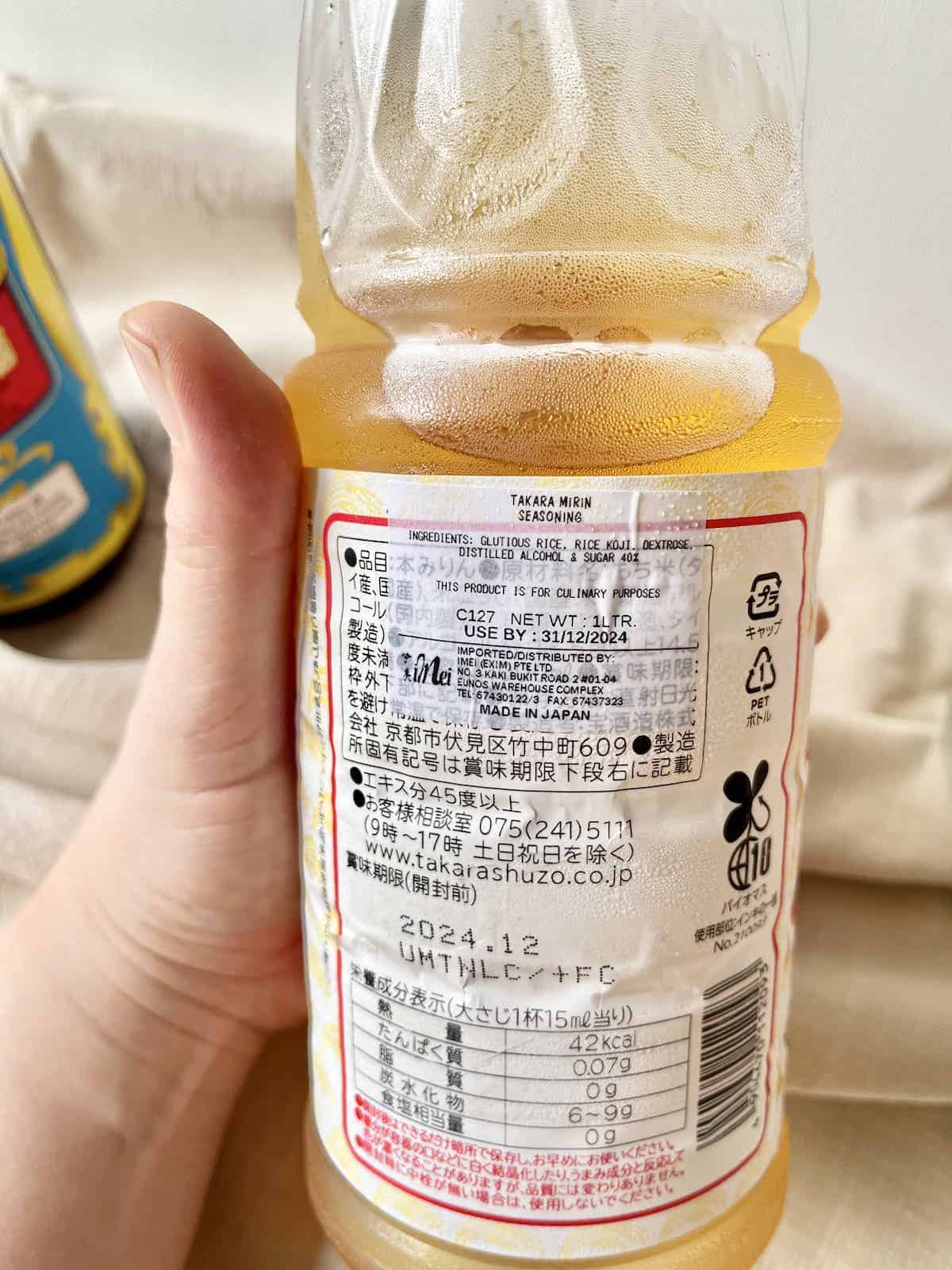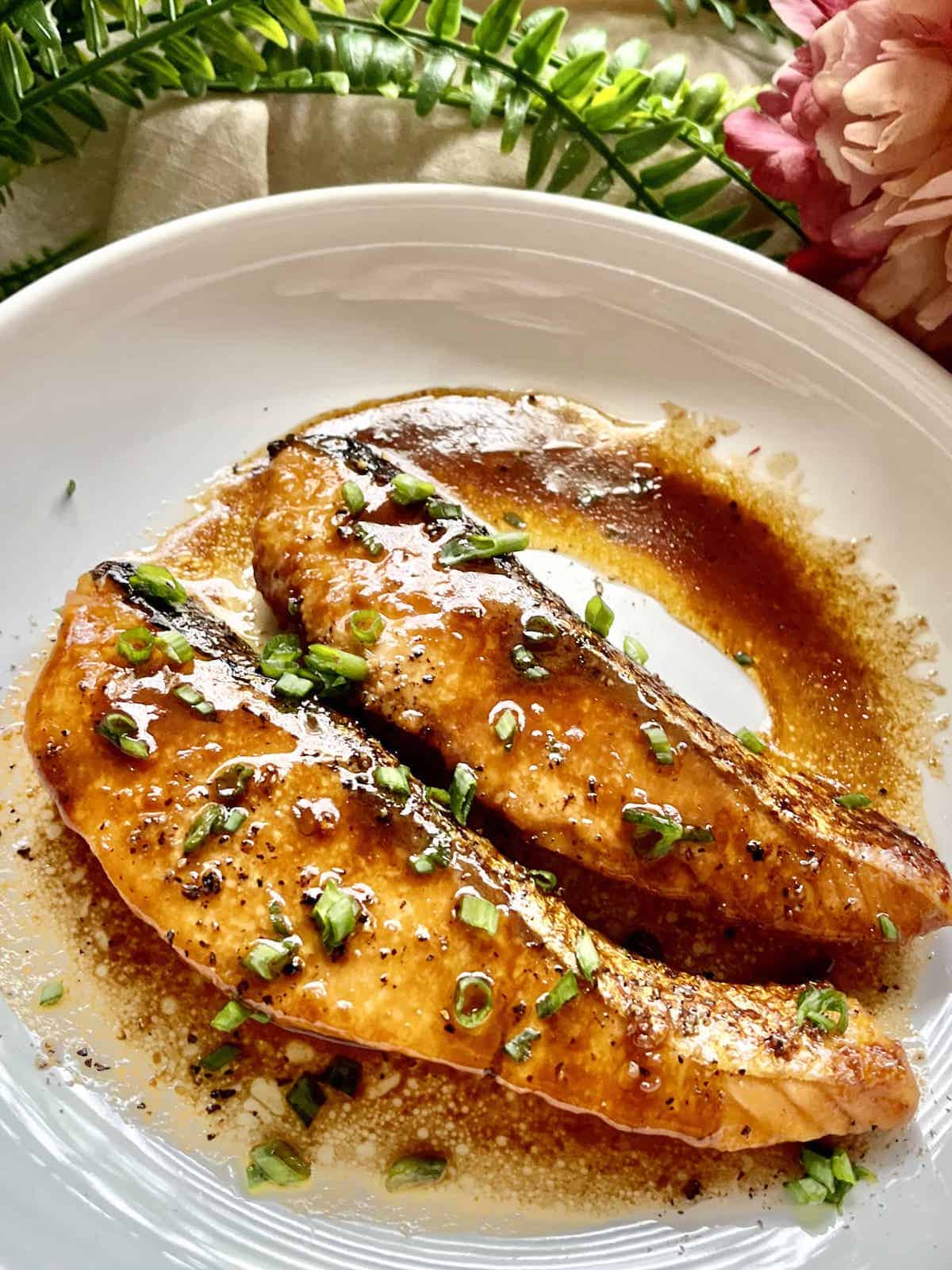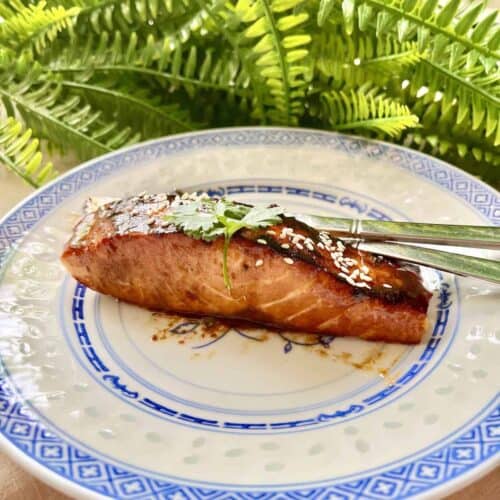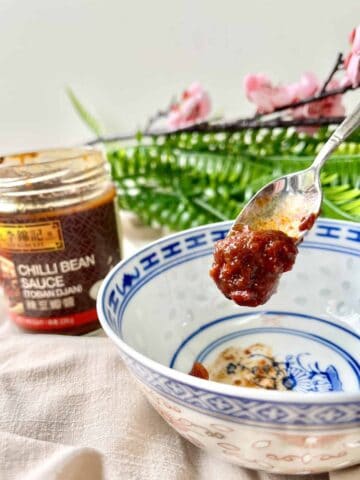Shaoxing Wine vs Mirin: the similarities and differences between these 2 Asian cooking wines as well as when they can be substituted for each other and when not.

Mirin and Shaoxing wine are both popular Asian cooking wines. Both are available at Asian grocery stores. Like wines in various cuisines, they're used to:
- improve the flavor of food
- remove unappetising smells (such as overpowering seafood or meaty smells)
- tenderise meat
However, they differ significantly in terms of origin, flavor, appearance, and uses.
To Summarise in 1 sentence: Mirin is a sweeter rice wine used for Japanese food and Shaoxing a dryer rice wine used in Chinese food.
Origin & Production

- Mirin: Originating from Japan, mirin (みりん, 味醂) is a sweet rice wine. It's made by fermenting glutinous rice, rice koji (a fermentation starter), and distilled alcohol. The mixture is allowed to ferment anywhere from two months to several years, giving it a light, sweet, slighlty floral, and almost bright flavor. It's a must in a Japanese kitchen!
- There is "Hon-mirin" (true mirin) and cooking mirin- the former has a higher quality and thus a higher price! I usually get Hon mirin to cook with.
- Shaoxing Wine (shào xīng jiǔ 绍兴酒): Also known as huā diāo jiǔ 花雕酒, Shao-hsing or Shaohsing wine, it is a savory Chinese rice wine from Shaoxing city in the Zhejiang Province, China. Made from brown glutinous rice and typically aged for 10 years or more, this centuries old wine has a longer aging process that gives it a deeper and more complex flavor. It's an essential ingredient if you enjoy cooking Chinese food! (See Photo Below) Despite what you may read in other blogs, it is NOT spicy.
- There is Drinking Grade Shaoxing (no salt, more expensive, con be drunk as an alcoholic beverage) and cooking Shaoxing. I usually cook with cooking Shaoxing.
- There is wheat added to the rice, so Shaoxing is not gluten-free.
- If a Chinese recipe calls for cooking wine, it's almost definitely referring to Shaoxing. (There are other Chinese rice wines, such as Clear Rice Wine/ mǐjiǔ 米酒 and Clear Chinese Rose Wine Mei Kwei Lu.)


Flavor


- Mirin: This sweet rice wine has a sweet flavor with a slight tang/ acidity primarily due to the sugar content- it can almost be said to have a floral quality- and can be almost syrupy. The alcohol content (8-14%) is lower compared to Shaoxing wine. (Shaoxing Wine is more similar to sake, which is often used together with mirin in Japanese cooking.)
- Shaoxing Wine: It has a rich, deep, and distinct flavor. (This Chinese wine is much less sweet than mirin.) The aging process contributes to its depth and complexity of taste. (Some cheaper brands have caramel added to it, to mimic the darker color of longer-fermented wines.) Alcohol content is usually around 16-25%. Cooking Shaoxing will also have had salt added to it to allow it to be sold in supermarkets.
Appearance

- Mirin: is a light clear yellow and be quick thick, like a syrup.
- Shaoxing: is thinner in consistency, almost like water or soy sauce. It can be anything from a clear amber to a dark brown color, depending on the fermentation process and how long it was aged for. (Some cheaper brands add caramel as a shortcut to color.)
Uses
Mirin

- Mirin: Commonly used in Japanese cooking, mirin is an essential ingredient in teriyaki sauce, sukiyaki, and other glazes or marinades. (See below for more recipes which use Mirin.) It is used to:
- sweetness helps to balance out salty flavors from soy sauce and miso
- tenderise ingredients
- mask the fishy smell/ gamey flavor in seafood and meat dishes respectively
- glaze food to make shinier and more attractive (thanks to Mirin's high sugar content- this is something Shaoxing cannot achieve on its own
Recipes with Mirin
Shaoxing

- Shaoxing Wine: Widely used in Chinese cuisine, it's a key ingredient in many marinades, stir-fries, and sauces. (See below for recipes which use Shaoxing.) It's used to:
- add a savory depth of flavor to food, e.g. in Chinese Drunken Chicken (this is something Mirin cannot do alone)
- tenderise ingredients
- eliminate the strong odors of meats and seafood, such as in this fish congee recipe
Recipes with Shaoxing
Similarities
Mirin and Shaoxing wine have the following in common:
- Asian Cooking Wines: Both are traditional cooking wines used in Asian cuisine. Mirin is a staple in Japanese cooking, while Shaoxing wine is essential in Chinese cuisine.
- Made from Rice: Both are made from fermented rice. Mirin is made using glutinous rice, rice koji (fermentation starter), and distilled alcohol. Shaoxing wine is typically made from brown glutinous rice, and sometimes wheat.
- Flavor Enhancers: Both wines are used to enhance the flavors in various dishes. They add depth and complexity to the taste profiles, whether it's through sweetness, umami, or a balance of different flavors.
- Used in Marinades and Sauces: Mirin and Shaoxing wine are commonly used in marinades and sauces. Mirin often appears in teriyaki sauce and other glazes, while Shaoxing wine is frequently used in braising liquids and stir-fry sauces.
- Alcohol Content: Both contain alcohol- albeit different amounts- which plays a role in cooking. (It helps to tenderize meat and seafood and can meld flavors together in a dish.)
- Used to Mask Unwanted Flavors: Both wines are used to mask strong odors in meats and seafood, and enhance their natural flavors.
As Substitutes
Shaoxing and Mirin Wine have similarities and thus can sometimes be used interchangeably. However, they are not perfect substitutes.

For example, Shaoxing on its own cannot provide the sweet and floral flavor that Mirin brings.
In my opinion, if you are looking for a Chinese wine that is a good substitute for Mirin, small amounts of the sorghum liquor Chinese Rose Wine (Mei Kwei Lu 玫瑰露) is actually a better alternative. As you can see below, it contains sugar just like Mirin. (Just keep in mind it has a much stronger floral flavor and a MUCH higher alcohol content than Mirin!)


Chinese Rose Wine Ingredient Lable: Liquor, Rose, Sugar. Alcohol 54% by volume, Salt 4%.
Conversely, Mirin's sweet flavor can be too overpowering for dishes that require the more savory flavors of Shaoxing Chinese cooking wine. See below for when you should not use these two wines as substitutes for each other.
Note: the best substitute for Shaoxing is dry sherry in a 1:1 ratio (click through for other good alternatives.) The best alternative to Mirin is Japanese Sake and a little Sugar. (Use ¾ Tablespoons of Sake and ¼ Tablespoon of sugar to replace 1 Tablespoon of Mirin. Use white sugar, not brown sugar.)
Shaoxing Wine Vs Mirin: When NOT to use as Substitutes
Because Mirin is sweeter, it is not always a good alternative to Shaoxing Chinese cooking wine.
Here are some instances when you should not substitutes (and here are what shaoxing alternatives to use instead):
- In Traditional Cuisine: Authentic Chinese dishes that call for Shaoxing wine will lose their intended flavor profile if mirin is used. Drunken chicken, for example, won't taste the same if Mirin was used. Similarly, authentic Japanese cuisine uses mirin (and sake), not shaoxing! (This is not to say the resulting dish will taste bad- it just won't taste traditional.)
- Sweetness is Key to the Dish: Mirin has a notable sweetness that is integral to certain Japanese dishes, like teriyaki sauce, sushi rice, and glazes. Shaoxing wine is less sweet and more savory and thus not a good alternative. (If you have no choice, use ¾ Tablespoon of Shaoxing and ¼ Tablespoon of sugar in place of 1 Tablespoon of mirin.)
- In Savory Dishes Requiring Depth of Flavor: Shaoxing wine is often used for its bold and savory depth. Mirin, being sweeter, can overpower the savory notes of recipes like stir-fries, braised meats, and marinades that traditionally use Shaoxing wine.
- The Dish has a Delicate or Mild Flavor: For dishes with delicate or subtle flavors, the robustness of Shaoxing wine might be overpowering. Use a simple sugar syrup (water + sugar) instead.
- When Alcohol Content Matters: If you're cooking a dish where the alcohol content is important, mirin (which typically has a lower alcohol content and also has non-alcoholic versions) might not be a suitable substitute for Shaoxing wine. This is especially true in recipes where the wine's higher alcohol content is integral to the dish's flavor or texture.
- You'e on a Low-Sodium Diet: As Shaoxing wine is less sweet, you would need to add more sugar to achieve a similar taste to mirin. This would result in a need for more salt or soy sauce to balance the sweetness.
- When on a Low-Sugar diet: If you're trying to reduce the sugar content in your cooking, substituting mirin for Shaoxing wine is not advisable due to mirin's higher sugar content.
- For Gluten-Free Cooking: While many brands of mirin are gluten-free, Shaoxing wine can sometimes contain wheat, making it unsuitable for those with gluten sensitivities or celiac disease. It’s essential to check the labels if this is a concern.
- In Dishes Where Color Matters: Mirin is generally clearer and lighter in color, while Shaoxing wine can impart a richer, darker hue to dishes. This can be a consideration in recipes where the final appearance is important.

Frequently Asked Questions
Both cooking-grade Shaoxing and cooking-grade Mirin are available at most major Asian supermarkets. For specific types, such as drinking Shaoxing, spiced/ herbal Shaoxing, or Hon-Mirin, you may need to go to a Chinese supermarket or Japanese supermarket respectively. (Or go online!)
An open bottled of cooking Shaoxing wine does not need to be put in the fridge whilst cooking-grade Mirin does, due to the lower alcohol content. (Hon-mirin, the higher grade Mirin, and cooking-Shaoxing can both be sealed tightly, then left in a cool and dark pllace. If you leave Hon-mirin in the fridge, sugar crystals may form. (Note that exposure to light may cause the flavor to deteriorate.) However, cooking-Shaoxing has a longer shelf life (check the date on the bottle): both cooking and Hon-mirin can only be kept for up to 3 months after opening.
Whilst both are important condiments for Asian cooking, rice vinegar differs significantly from rice wine in flavor and acidity. It is not an ideal replacement for rice wine by itself. If you have no choice, combine it with other ingredients, such as white grape juice, to create a better alternative.
Any questions about how to use Shaoxing vs Mirin cooking wine? Let me know in the comments! To learn about Shaoxing vs Sake, click here!













Comments
No Comments